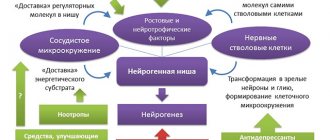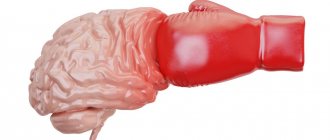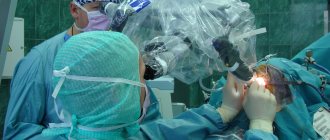Speech development delay (SSD) is a pathology associated with the child’s inability to speak in a connected manner. Normally, a child should develop a sufficient vocabulary by the age of 2-3 years. If this does not happen, we can talk about ZRR. The final diagnosis is made by a pediatric neurologist.
Today, there are many treatments for cerebral palsy. In most cases, good results can be achieved if drug therapy is combined with physiotherapeutic procedures. This helps stimulate the baby's nervous system and facilitate the child's learning process.
Characteristics of the technique
Non-invasive procedures have significant advantages over surgical ones and are becoming increasingly popular for use in modern medicine. The idea of using small direct current to accelerate the recovery of nerve cells was invented by Soviet scientists, and has not lost its relevance. It is easy to confuse micropolarization with other non-surgical treatments, such as electromagnetic stimulation.
It is a mistake to believe that this is the same procedure as micropolarization, because they are both aimed at restoring brain neurons. The difference is that the methods are based on different influencing factors: a magnetic neuron stimulator and an electronic one. Magnetic stimulation of the cerebral cortex involves exposure to a weak electromagnetic field, while micropolarization involves stimulation with a low current.
The main advantages of micropolarization in comparison with other techniques are that it is harmless and painless, therefore suitable for children with central nervous system dysfunction. There are two types of micropolarization:
- Transcranial micropolarization is the same as TCM of the brain. With transcranial micropolarization, electrodes are applied directly to the area of the skull occupied by the brain. This type of procedure affects the cerebral cortex and deeper internal structures.
- Transvertebral micropolarization is the same as TVMP - this is a method in which electrodes are applied to the vertebral area. With this type of micropolarization, electronic impulses affect parts of the spinal cord, as well as some areas of the brain.
Both methods are widely used in medicine to treat diseases caused by dysfunctions of the central nervous system. Both independently and as part of complex therapy, the micropolarization method will help shorten the recovery period of the central nervous system and strengthen neural connections.
There are no contraindications for brain micropolarization based on age, gender or other characteristics; indications include the treatment of neurological diseases in children. Micropolarization helps in the treatment of a number of childhood diseases associated with disruption of the central nervous system and allows you to quickly restore its functions. The technique is aimed at increasing the child’s brain activity, improving speech and memory, and getting rid of the manifestations of developmental delays.
How does micropolarization occur?
Subspecialists who monitor his condition can refer a small patient for transcranial micropolarization of the brain. A referral can be given by a speech therapist, psychiatrist, neurologist, psychotherapist or physiotherapist.
Many specialists in the field of child neurology, psychiatry and speech therapy prefer transcranial micropolarization
Before a course of micropolarization of the brain, the baby will need to undergo a medical examination to exclude the presence of contraindications, as well as to record the initial state. The latter will be required to track dynamics during therapy. This way you can understand how effective the stimulation is.
Usually a course of transcranial micropolarization is prescribed, consisting of 8-12 procedures, each of which lasts no more than 50 minutes. A special cap with electrodes is placed on the child’s head; the latter are attached to the areas required for treatment with the reverse side. Therapeutic manipulations are carried out on an outpatient basis. In order to get a visible and lasting effect, it is recommended to repeat the course 12-24 weeks after the end of the first.
Parents should take into account that during the treatment the little patient should not make sudden movements or twist a lot - this can lead to displacement of the electrodes, and therefore reduce the effectiveness of the procedure.
In many clinics, a computer is placed next to the equipment, on which the child can play or watch his favorite movie during treatment. If such a service is not provided at the medical institution, then parents need to take with them an interesting book or tablet computer to keep the baby occupied during therapy.
Indications for the procedure
Micropolarization affects the affected neural areas in different zones, so this procedure is successfully used in the treatment of a large number of diseases, for which it is widely used by doctors. Indications for the procedure include:
- Violation of musculoskeletal functions. The technique demonstrates a pronounced therapeutic effect in cerebral palsy, muscle rigidity and other motor dysfunctions caused by damage to brain neurons.
- Delayed speech development. Micropolarization during speech development delays has a stimulating effect on the speech areas of the brain. After completing a course of procedures for mental retardation, the quality of speech improves significantly. Micropolarization of the brain during speech delays helps the child express thoughts in logical, structured phrases. The technique is used for motor and partially sensory alalia and other speech disorders.
- Behavioral disorders. A course of TCM is prescribed to young patients with hyperactivity and impulsive behavior.
- Violation of visual and auditory functions. Strabismus, amblyopia, sensorineural hearing loss – indications for testing.
- Epilepsy. The impact of microcurrent on the brain activates the internal antiepileptic system of the brain, which gives positive results.
- Autism. As a result of the influence on the frontal lobes of the brain, insufficiently plastic neurons are activated in autism. As a result, the child experiences greater interest in the world around him and his development progresses.
- Consequences of neuroinfectious diseases and traumatic brain injuries.
- Neuroses and similar conditions, psychogenic enuresis, encopresis.
- Damage to the blood vessels of the brain and cranial nerves.
The therapy method is used for other diseases caused by dysfunction of the central nervous system. The neurologist will individually recommend the program and duration of treatment, taking into account the type of disease, the nature of the course, the prevailing symptoms and other factors. The microcurrent technique will not cause harm; on the contrary, even the well-being of a healthy person will improve after the course.
Efficacy for treating diseases
Transcranial micropolarization is considered one of the most effective methods of treating nervous system disorders. It is safe and can be used in the treatment of diseases in patients of any age.
It is important to understand that the procedure has a different effect on different patients - for some, the therapy eliminates the physiological causes of the disease, for others it only helps to increase socialization and learning ability. Therapy is prescribed in courses, but the effect is noted after the first stimulation procedure. Of course, it is difficult to notice changes with the naked eye, but they are clearly visible on the control encephalogram.
Treatment allows you to achieve the following results:
- the functioning of the pelvic organs is normalized;
- motor functions of the upper and lower extremities are restored;
- hearing and vision improve;
- mental activity increases;
- the functioning of the speech apparatus is normalized;
- impaired psychological functions are restored.
Contraindications
This method makes a significant contribution to the fight against diseases caused by disruption of the central nervous system. Micropolarization is completely safe, painless and does not cause side effects. The current strength used during the procedure is so small that it is not felt by the body. But, as with any other method, micropolarization has contraindications. Neurologists recommend refraining from the procedure if:
- Intolerance of the patient's body to electric current.
- The presence of malignant tumors.
- The presence of a foreign body in the brain or spinal cord (for example, implants).
- Increased or decreased body temperature.
- Blood diseases.
- Damaged skin.
If you have the above contraindications, you must notify your neurologist in advance. There are other contraindications that depend on the characteristics of the patient and his illness, so it is important to consult an experienced specialist before starting the course.
results
After the first month of using micropolarization, normalization of muscle tone, improvement in cognitive functions of the brain, improvement in concentration, acceleration of development and reduction in hyperactivity with impulsivity are usually noted. Children begin to speak better, show interest in various subjects, and learning goes much faster and easier. In children with cerebral palsy, spasticity decreases, range of motion increases significantly, and the sense of support and fine motor skills improves. As for the emotional state, micropolarization relieves fears, panic attacks and aggression, normalizes sleep, improves the ability to contact people and improves mood. Positive changes have been noted in sensorineural hearing loss.
Unlike drug therapy, micropolarization is 80% more effective than taking medications, since it acts directly on the desired areas of the spinal cord or brain.
This procedure is performed with caution in children with various genetic diseases leading to speech and mental development disorders, including autism and Down syndrome. In these cases, most often no special results are observed - or they exist, but are quite insignificant, and the child’s condition does not worsen.
It is also important to take into account that micropolarization cannot be combined with acupuncture, electrical stimulation, myostimulation using vibration, as well as with the simultaneous use of forced-action psychotropics. This is due to the fact that micropolarization stimulates the brain, and additional third-party stimulation in the form of the use of other devices and medications can lead to pathological seizure activity due to overexcitation of the brain. It should be noted that cortical excitability, manifested by epileptic seizures and myoclonus, is also recommended to be suppressed using low-frequency rhythmic transcranial magnetic stimulation (TMS).
The procedure can and should be combined with corrective massages (as prescribed by the attending physician) and visits to a qualified psychologist and neurologist (as indicated). Also, before micropolarization, electroencephalography should be done, based on the results of which the doctor will be able to draw up a scheme for applying electrodes to increase the effectiveness of the procedure. This is very important, since the brain map of each person is absolutely individual, since the functional brain areas do not have a clear localization, but have their own characteristics that must be taken into account when performing micropolarization.
Another important nuance is that neural networks in the brain constantly interact with each other, so if the activity of one network is changed by micropolarization, this may affect the state of other neural networks. In this regard, micropolarization cannot be carried out at the behest of the left heel - there must always be specific indications with preliminary studies from professional specialists.
How to perform the procedure
A mandatory step before micropolarization is a brain examination. The technique of influencing damaged areas of the brain is not used without a preliminary examination. MRI, electroencephalography and other studies help the doctor identify damaged areas of brain structures. This stage requires experience - the result of treatment depends on the correctness of the doctor’s conclusion. When violations are detected, all that remains is to go through the procedure.
The electrodes are fixed on the patient’s head in places where damage to neural structures is detected, using special elastic bands. When the doctor turns on the device, a small direct current flows through the wires to the electrodes, and they transmit impulses to the affected lobes of the brain. Micropolarization takes place under the continuous supervision of a physician.
The session lasts 20-40 minutes, the course of treatment is 10-15 sessions. The procedures are carried out every other day. Micropolarization cannot be combined with drug treatment, because the therapeutic effect may be unpredictable. The duration of the course depends on the characteristics of the patient. To achieve maximum results, doctors recommend undergoing a repeat course of procedures after 2-4 months.
Nuances
In many cases, micropolarization can completely replace drug therapy with the use of nootropics, which have a negative effect on the human and, especially, children’s body. The procedure itself in an outpatient setting may look unusual: a special helmet with electrodes is put on the patient’s head and a current is connected. During the process of exposure, the nervous substrate in the places where the electrodes are applied is noticeably activated, which causes a number of improvements in this or that pathology. At the same time, during the procedure it is not prohibited to load the brain - for example, you can surf the Internet, watch a movie or listen to music, which is very important for small, restless patients.
In order for micropolarization to have the maximum therapeutic effect, the doctor must correctly place the electrodes on the segmental projections relevant to the treatment of a specific problem.











